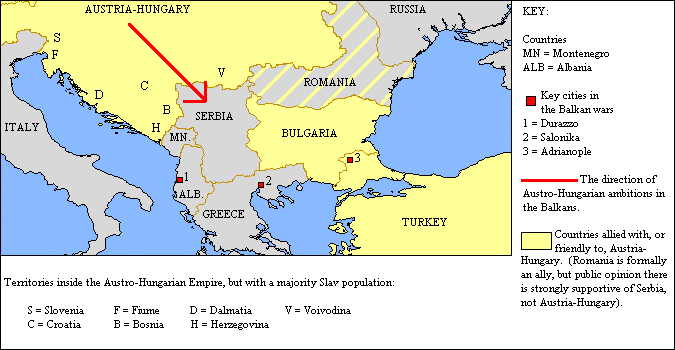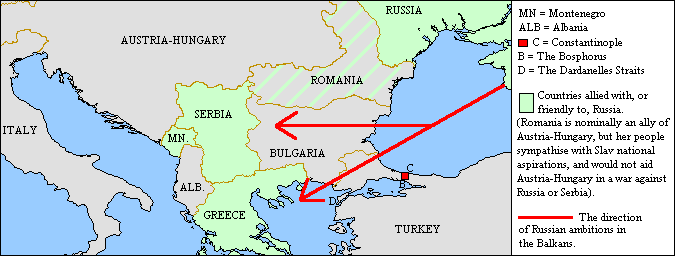And it will start in the East."
-- Otto von Bismarck to German industrialist Alfred Ballin, 1891
Sensing that Turkey is too weak to hold on to her remaining possessions in the Balkans, four of her former provinces - Serbia, Montenegro, Greece and Bulgaria - come together to launch a surprise attack on her in October 1912. To the surprise of the rest of Europe, the Turkish Army collapses before the assault, and the Balkan allies make significant gains - the Greek Army captures Salonika, the Bulgarians advance all the way to Turkey's capital, Constantinople, and the biggest winner of all, Serbia, doubles her territory and captures the Adriatic port city of Durazzo, giving her a long-desired outlet to the sea.
On 3 December 1912, an armistice is declared, and the two sides meet to discuss peace terms. Talks founder over the status of the city of Adrianople, which Bulgaria demands as the price of peace, but which Turkey is unwilling to relinquish. Fighting resumes in the Second Balkan War of February to May 1913, and the status of Adrianople is resolved when it is captured by a combined Serbian-Bulgarian Army.
On June 29, just one month after the end of the Second Balkan War, when peace seems to have returned to the region, Bulgaria suddenly turns on Serbia and Greece, and seizes from her unprepared former allies many of their gains from the first two wars. But while the Bulgarian is campaigning against Serbia and Greece, Turkey and the formerly-neutral Romania attack Bulgaria's rear, and force her to come to terms which strip from her all her gains from the Balkan Wars.
When the wars finally end on 6 August 1913, Bulgaria (a friend and potential ally of the Triple Alliance) is left diplomatically isolated, and is territorially weaker than when she first went to war. Romania has clearly drifted out of the orbit of her nominal ally, Austria-Hungary, and is now closely aligned with Montenegro, Greece and Austria's great enemy, Serbia. Serbia herself is territorially and diplomatically stronger as a result of her military successes, and more than ever is a beacon to the millions of Slavs of Austria-Hungary, many of whom would prefer to be part of a greater Slav nation, led by Serbia, than remain one of the many minority races of the Austro-Hungarian Empire.
As far as Turkey is concerned, the Balkan wars obviously diminish the Turkish Empire's already tenuous influence on the region. And as Turkey's authority declines, the two Great Powers of the region -- Austria-Hungary and Russia -- aspire to fill the power vacuum, and to become the dominant force in the Balkans.
& Austria-Hungary's Ambitions in the Region

In 1878, the Congress of Berlin gave a mandate to Austria-Hungary to occupy and administer the Turkish provinces of Bosnia and Herzegovina. This decision bitterly disappointed the Slav (ie Serb and Croat) populations of the two provinces, as well as Serbia, which aspired to lead the divided Slav peoples of the Balkans in a single Greater Serbia. Since 1878, the question of who should rule in Bosnia and Herzegovina had left Serbia and Austria-Hungary irrevocably opposed.
Austria-Hungary's occupation of Bosnia and Herzegovina added over a million Slav subjects to the Empire, with the result that by 1913 twice as many South Slavs lived inside the Austro-Hungarian Empire as outside it. Many of these Slavs saw their future in a single, united Slav nation under the leadership of Serbia, not as provinces of the Austro-Hungarian Empire. Their aspiration to be part of a single Yugoslav (ie South Slav) nation, was a dangerously destabilising movement in an Empire which was a creaking mosaic of diverse nationalities.
The immediate aim of Austria-Hungary's policy in the Balkans in 1913 was to isolate Serbia, by creating a Balkan League of Romania, Greece and Bulgaria. Beyond this, there was no unanimity in Austria-Hungary about how the permanent pacification of Serbia would be achieved. The Heir to the throne, Archduke Franz Ferdinand reportedly favoured "Trialism", which meant creating a united Yugoslav state which would be inside the Empire, but on an equal footing with Austria and Hungary. But some in the conservative ruling class of the Empire were beginning to see the crushing of Serbia by military force as a more effective way of dealing with Slav agitation. A preventative war with Serbia seemed preferable to the kind of slow decomposition afflicting the Ottoman Empire, and more bearable than the protracted negotiations and painful compromises that would be necessary to transform the dual structure into a triad. The leading proponent of a preventative war was the Austrian Chief of Staff, Baron Conrad von Hotzendorf, who believed that Serbia should be subjugated by conquest followed by outright annexation or "reduction", ie assigning portions of Serbian territory to Bulgaria, Greece and Albania, leaving only a remnant to continue as an independent state.
Map 1 shows that if Austria-Hungary could succeed in pacifying Serbia -- by whichever means -- the influence of the Triple Alliance would extend from Berlin to the Persian Gulf. Austria-Hungary's regional rival, Russia, would be penned in helplessly behind the Bosphorus Straits, and thus excluded from influence in the Balkans and the eastern Mediterranean.
& Russia's Ambitions in the Region

Russia's own national interests in the region were also closely affected by the relative strength or weakness of Turkey, which ruled the Bosphorus and Dardanelles Straits, and so effectively controlled Russia access to the Mediterranean. The 1871 Treaty of London denied all foreign warships access to these Turkish waters, and although this protected Russia from attack by the back door it also trapped her Black Sea Fleet in that sea. So a second Russian goal in the region was to force Turkey to allow passage through the Straits to Russian warships.
In 1913, Russia's immediate aim to promote the closest possible relations between Serbia, Romania and Greece -- the members of the Balkan League which had emerged victorious from the Second Balkan War -- and to safeguard the territorial gains which those nations had made in that war. The existence of such a combination would serve as a barrier to the Balkan ambitions of Austria, driving a wedge from the Black Sea to the Adriatic between the members of the Triple Alliance and those nations which aspired to membership (Turkey and Bulgaria). It would also bring pressure to bear on Turkey, and make her more amenable to Russian demands for access to the Bosphorus.
Maps 1 & 2 show that, by 1913, Serbia occupied a key position in European politics. Her subjection by the Austro-Hungarian Empire was as intolerable for Russia as it was desirable for Austria-Hungary. Neither Russia nor Austria-Hungary could be defeated on the Serbian question, without seeing the balance of power in the Balkans shift decisively to the other.
In an attempt to contain the crisis, British Foreign Minister Sir Edward Grey suggests a conference of the Great Powers, which opens in London on 10 December 1912 and comprises (in addition to Grey himself) the London Ambassadors of Germany, France, Austria-Hungary, Russia and Italy). The Conference provides a friendly forum, where the Great Powers can meet face-to-face to resolve the issues which threaten to engulf them all. Instead of going to war over Durazzo, Russia and Austria-Hungary's Ambassadors reach a compromise. Under Russian pressure, Serbia gives up its newly-acquired port. Out of Durazzo and its surrounding area, the Powers create the new nation of Albania, whose frontiers are eventually settled to the satisfaction of all the participating and regional powers. When the Conference of London eventually closes in August 1913, the danger of a general European war seems to have been averted.
we all put out anchors to prevent ourselves from being swept away. The anchors held. Then the current seemed
to slacken and the anchors were pulled up. The Conference was allowed to dissolve. We seemed to be safe."
Sir Edward Grey, British Foreign Secretary.